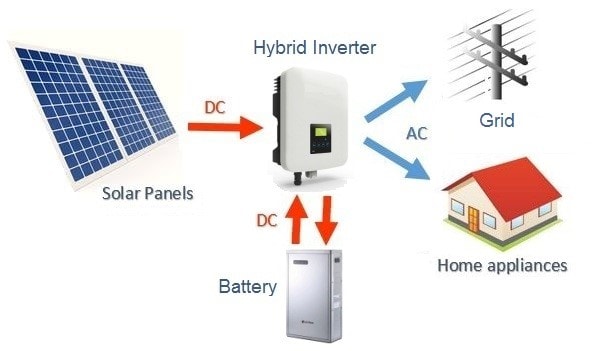Overview
The hybrid solar energy system integrates on-grid and off-grid solar energy systems into one system. In simple terms, it’s a solar power system that’s connected to the power grid and also has a battery backup. It has the advantage of storing energy in the battery when the solar panel is at its most efficient and retrieving it during peak nighttime hours when electricity rates are high or in the event of a grid failure. In addition, one can sell excess energy created to the power grid and be compensated for it.
In principle, the hybrid system works similarly to an off-grid system. But, after charging the batteries and meeting the load requirements, the hybrid system is capable of exporting the excess solar generation to the grid. Moreover, any shortfall in solar generation is compensated by importing electricity from the utility grid, e.g., to charge the batteries or power the load. The net energy is measured by a bi-directional meter based on the energy imported and exported between the system and the grid.
How It Works ?
The photovoltaic system generates direct current (DC) when solar energy in the form of photons is reflected on the solar panel. The amount of DC energy produced is determined, based on the amount of solar radiation received. This DC energy is delivered to the charge controller, which aids in the regulation of power supplied to the battery. The inverter absorbs energy from these batteries and turns it into a useful alternating current, depending on the power requirements. The wiring system distributes the generated AC energy to various loads. When the battery is fully charged, the solar panel sends the excess DC power generated by the solar panel to the utility grid through the inverter and net metre, and this power will fetch your payment from your grid office. Depending on the need, the battery’s stored energy is extracted during non-sunny days or at night.

Pros
- Reduced reliance on the grid
- Hybrid inverters include backup power capacity, ensuring that electricity is available at all times. It allows customers to use power from the grid, batteries, or solar panels, ensuring the power is uninterrupted.
- In the event of a power cut, a hybrid solar energy system can be used as an off-grid solar energy system.
- During days when the sun fails to come out or during peak evening hours (when tariff rates are high), stored energy can be retrieved, resulting in lower electricity bills.
Cons
- System is little costlier compared to on-grid and off-grid because of its unique feature
When to select the hybrid solar system?
It makes sense to install a hybrid solar energy system if you have situations like –
- Low feed-in tariff: Hybrid power systems are worth installing in areas where feed-in tariffs are low. Solar panels operate at their peak throughout the day, especially around noon, but because household use of electricity is often lower during this time, the majority of the surplus energy is exported to the grid at a cheap cost per unit of electricity. However, if the solar panels do not create enough electricity in the evening, we must import it from the grid, which is more expensive than the cost gained when exported.
- Frequent power blackouts: Installing a solar hybrid system in a location with frequent blackouts and a low feed-in-tariff rate is a reasonable option, but one must ensure that a suitable backup system is in place to run crucial loads.
